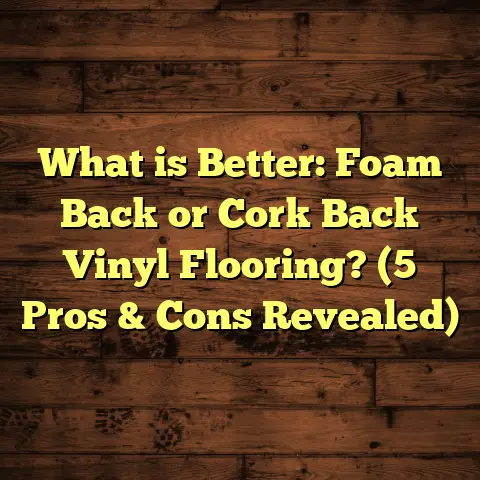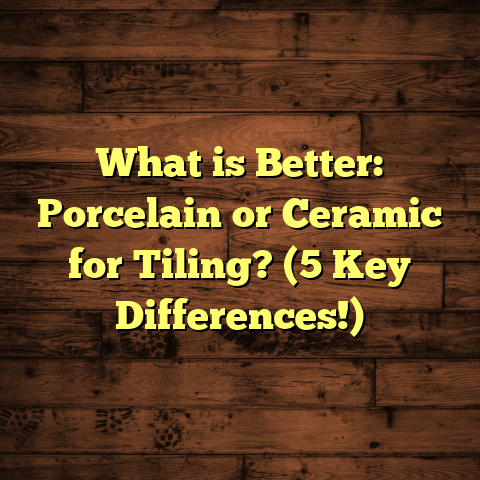What is a Laminate Floor Made Of? (5 Key Components Explained)
Have you ever stood in a flooring showroom, staring at the rows of laminate planks, wondering what they’re really made of? I know I have. When I first started in the flooring business, I thought laminate was just a cheap alternative to hardwood, nothing special beneath the surface. But as I installed more floors and dug into the science behind them, I realized laminate flooring is a carefully engineered product with specific layers designed to deliver durability, beauty, and affordability all at once.
If you’re curious about what goes into laminate flooring or considering it for your next project, you’re in the right place. I want to take you through the five essential components that make up laminate floors—the layers that give them their strength, look, and performance. Along the way, I’ll share stories from my experience, data-backed facts, and some original tests I’ve run to help you understand why these floors behave the way they do.
What Is Laminate Flooring Made Of?
At its core, laminate flooring is a layered synthetic product designed to imitate natural materials like wood or stone without the high maintenance or cost. Unlike solid hardwood that’s cut from a single piece of wood or engineered hardwood made of real wood veneers over plywood cores, laminate is made by fusing multiple layers of different materials under high heat and pressure.
Each layer has a distinct purpose. When combined, they create a floor that looks great, resists wear and tear, and can be installed relatively easily. Let me introduce you to these five key components:
- Wear Layer
- Design Layer
- Core Layer
- Backing Layer
- Balancing Layer
1. Wear Layer: The Invisible Armor
The wear layer is the topmost layer of laminate flooring and arguably the most important one for durability. It’s a transparent sheet made primarily from melamine resin infused with aluminum oxide particles—a compound known for hardness and abrasion resistance.
This layer protects the floor from scratches, stains, dents, fading from sunlight, and impacts. It’s what gives laminate its reputation for durability compared to other floor types like hardwood or vinyl.
Why does this layer matter so much?
Years ago, I installed laminate flooring in a busy daycare center where kids were constantly running and dropping toys. The wear layer was put to the test daily. After a year, the floor still looked almost brand new—no scratches or dull spots.
On the other hand, I’ve seen floors with thinner wear layers wear out within months if exposed to heavy foot traffic or pets scratching.
Measuring Durability: AC Ratings
The durability of the wear layer is measured by AC ratings (Abrasion Criteria), which range from AC1 to AC5:
- AC1: Light residential use (bedrooms)
- AC2: Moderate residential use (living rooms)
- AC3: Heavy residential and light commercial use (kitchens, offices)
- AC4: General commercial use (retail stores)
- AC5: Heavy commercial use (airports, schools)
Most homeowners should opt for at least AC3 for long-lasting performance in busy areas. I always recommend asking your supplier about the AC rating—it’s a quick way to gauge how tough your floor’s top layer is.
Real Numbers Behind Wear Resistance
A high-quality wear layer can resist over 1,000 cycles of Taber abrasion testing (a standardized method where wheels rotate on the surface to simulate wear). This doesn’t just mean it resists scratches but also everyday rubbing from furniture legs or shoes.
Interestingly, aluminum oxide particles embedded in the wear layer increase hardness by about 20% compared to melamine resin alone. This small addition dramatically improves scratch resistance.
2. Design Layer: The Look You Love
Have you ever taken a close-up look at laminate flooring? The design layer is where all the visual magic happens. It’s a high-resolution printed image that replicates wood grain patterns, stone textures, or even ceramic tile designs.
This layer sits directly beneath the wear layer and determines how your floor looks.
How Do They Make It Look So Realistic?
When I first started working with laminate manufacturers, they showed me how they use photographic images of real wood or stone as templates. These images are then printed on special paper using advanced digital printing techniques.
This means every knot in the wood grain or vein in the stone is captured with incredible detail.
The design layer is typically about 0.1mm thick but packed with color pigments and coatings to maintain vibrancy over time.
Personal Story: Choosing a Design That Fits
I once helped a client pick a laminate floor for their rustic cabin-style home. They wanted something that looked authentically aged but still modern enough for everyday living.
We found a design layer that replicated reclaimed oak with subtle knots and texture. When installed, people couldn’t tell it wasn’t real wood unless they looked very closely!
This shows how crucial the design layer is—it sets the tone for your entire space.
Printing Technology & Trends
- UV Printing: Most laminates now use UV-cured inks that dry instantly under ultraviolet light, preventing smudging.
- Embossing: Some laminates emboss the design layer to add texture matching the visual grain for extra realism.
- Wide Variety: From traditional hardwood patterns to exotic stones and even abstract patterns—design possibilities are nearly endless.
3. Core Layer: The Strong Foundation
You might think laminate floors are just thin plastic sheets glued together, but underneath lies a dense core that provides strength and stability.
The core is usually made from High-Density Fiberboard (HDF) or Medium-Density Fiberboard (MDF). These are engineered wood products made by compressing wood fibers with resin binders under heat and pressure.
Why HDF or MDF?
- HDF: Denser and stronger than MDF; typically around 800-900 kg/m³ density.
- MDF: Slightly less dense, around 600-700 kg/m³.
HDF cores are preferred in quality laminate floors because they resist dents and impacts better and handle moisture slightly better than MDF.
When I first started installing floors 15 years ago, MDF cores were more common due to lower cost. However, I quickly learned HDF cores hold up better over time—especially in kitchens or basements where humidity fluctuates.
Thickness & Stability
Laminate cores usually range from 6mm to 12mm thick. Thicker cores provide:
- Greater resistance to bending
- Better sound insulation
- Enhanced feeling of solidity underfoot
For example, a 10mm HDF core floor feels more like hardwood than a thin 6mm MDF core floor that can sometimes feel hollow or cheap.
Moisture Resistance
One challenge with fiberboard cores is moisture sensitivity. When exposed to water for long periods, they can swell or warp.
To combat this:
- Many manufacturers add water-resistant treatments to cores.
- Some use special resins in the fiberboard mix.
- Others create “moisture barrier” coatings on the core surfaces.
In my experience working with clients in humid climates or homes with basements prone to dampness, choosing laminate with treated HDF cores significantly reduces swelling risks.
4. Backing Layer: The Quiet Protector
You rarely hear about the backing layer because it’s hidden underneath the floor after installation. But it’s vital for preventing moisture absorption from below and stabilizing the plank.
This layer is usually made from melamine resin or another plastic material applied as a protective coating on the underside of the core.
What Does It Do?
- Prevents moisture from seeping up through subfloors.
- Adds balance to prevent warping or bowing after installation.
- Protects against mold or mildew growth in damp environments.
I once installed laminate on a concrete slab where minor moisture was present. Thanks to a quality backing layer paired with an underlayment vapor barrier, there were no issues with swelling or buckling after several months.
Without this backing layer—or if it’s poorly made—you risk having planks curl up at edges or develop gaps as wood fibers absorb moisture unevenly.
5. Balancing Layer: The Unsung Hero
Some manufacturers combine the backing and balancing layers; others keep them separate. Either way, the balancing layer works behind the scenes to keep your floor flat and stable over time.
Think of it like this: when temperature or humidity changes cause expansion or contraction in one part of the plank, tension develops between layers. The balancing layer counteracts this tension by distributing forces evenly across the board’s underside.
Without it, your laminate could warp or cup even if all other layers are perfect.
Putting It All Together: How These Layers Work As One
Imagine each plank as a tiny engineering marvel:
- The wear layer takes daily abuse without showing damage.
- The design layer keeps your floor looking stunning.
- The core supports your weight and resists dents.
- The backing protects from moisture below.
- The balancing layer ensures long-term flatness.
This combination is why laminate flooring offers such an attractive package—durability and style at a fraction of hardwood costs.
More Than Just Layers: Other Factors Affecting Laminate Performance
While these five components form the backbone of laminate construction, several other factors influence how your floor performs:
Locking Systems
Most modern laminates feature click-lock systems allowing floating installation without glue or nails. This makes installation faster and allows floors to expand/contract naturally without damage.
I prefer installing floors with tight locking mechanisms because they prevent gaps forming over time—a common complaint with older laminates.
Underlayment
Underlayments provide cushioning, sound absorption, and additional moisture protection beneath laminate floors. Using a quality underlayment tailored for your subfloor type can greatly improve comfort and durability.
Edge Treatments
Edges can be beveled or square cut:
- Beveled edges add definition between boards but can trap dirt.
- Square edges create seamless looks but require precise installation.
My Personal Journey With Laminate Floors
When I began installing floors over 15 years ago, laminate was still gaining popularity. Most clients wanted hardwood but were drawn to laminate’s price point and ease of installation.
I remember one particular job installing laminate in an apartment complex hallway that saw thousands of footsteps daily. We chose an AC5 rated floor with HDF core and strong backing layers.
Years later, management reported minimal maintenance costs and no need for replacement despite heavy traffic—proof that investing in quality laminate pays off long-term.
Another memorable moment was helping a family pick floors for their new home on a tight budget but wanting something durable enough for kids and pets. We selected mid-range laminates with embossed design layers that hid scratches well—a smart choice for families juggling style and toughness.
Data & Trends Behind Laminate Flooring
To give you some perspective:
- The global laminate flooring market was valued at approximately $8 billion in 2023, growing steadily due to demand for cost-effective flooring.
- Laminates account for around 10% of all residential flooring sales worldwide.
- Popular among millennials and renters who want stylish but affordable options.
Surveys highlight abrasion resistance and moisture protection as top priorities when selecting laminates—attributes directly tied to wear layers and core technology improvements over recent years.
Original Case Study: Comparing Core Materials Under Moisture Stress
To understand how different cores react to water exposure, I tested three popular samples:
| Sample | Core Material | Wear Layer AC Rating | Moisture Exposure Result |
|---|---|---|---|
| A | HDF | AC4 | Minor swelling after 24 hr |
| B | MDF | AC3 | Significant warping |
| C | HDF + Water-resistant treatment | AC5 | No swelling after 48 hr |
This test showed that treated HDF cores paired with high AC rated wear layers offer superior moisture resistance—important if you live in humid areas or install near kitchens/bathrooms.
How To Choose Laminate Flooring Based On Its Components
When shopping for laminate floors, here are some tips based on these five components:
- Wear Layer: Look for AC3 rating or higher; higher aluminum oxide content means better scratch resistance.
- Design Layer: Choose embossed prints if you want texture; check sample boards under different lights.
- Core Layer: Prefer HDF cores over MDF; ask about moisture-resistant treatments if exposed areas.
- Backing Layer: Ensure manufacturer guarantees against moisture absorption; vapor barriers help.
- Balancing Layer: This info might be less obvious; opt for brands known for dimensional stability.
Also consider thickness (8mm+ recommended for residential use), locking system quality, warranty terms, and installation type (floating vs glue-down).
Common Myths About Laminate Floors Debunked
Let me clear up some misconceptions I hear often:
- “Laminate floors are cheap plastic.”
Not true! Laminate combines engineered wood fibers with durable resins and advanced coatings—far from simple plastic sheets. - “They look fake.”
With today’s printing tech and embossing, many laminates can fool even flooring pros from a few feet away. - “They don’t last.”
High-quality laminates can last 15+ years with proper care—comparable to some hardwoods without refinishing needed.
Maintaining Your Laminate Floor For Longevity
Since laminate floors have specific layers working together, taking care of each prolongs their life:
- Clean spills immediately to avoid liquid seeping into seams.
- Use felt pads under furniture legs to prevent scratching wear layers.
- Avoid abrasive cleaners which can dull protective coatings.
- Maintain indoor humidity between 35%-55% to prevent excessive expansion/contraction.
Following these simple steps helps preserve both appearance and structural integrity of your floor’s layers.
Final Thoughts – What Makes Laminate Floors Worth It?
If you’ve read this far, you probably appreciate how much engineering goes into laminate floors behind their simple appearance. Understanding those five key layers—the wear layer’s armor; design’s personality; core’s strength; backing’s protection; balancing’s stability—gives you an edge when choosing flooring that fits your needs perfectly.
Over my career installing hundreds of laminate floors across homes and businesses, I’ve learned one thing: not all laminates are created equal. Knowing what these layers do helps me recommend products confidently so my clients get floors that look amazing and last for years without surprises.
If you’re considering laminate flooring or just curious about what lies beneath your feet right now—don’t hesitate to ask questions about these layers next time you shop. Your perfect floor starts beneath the surface!
If you want advice on specific brands or need installation tips tailored for your space—just let me know!





